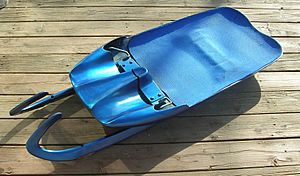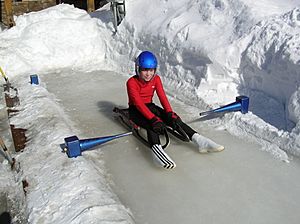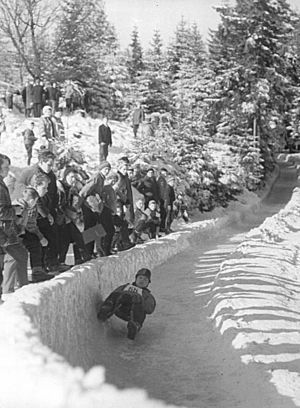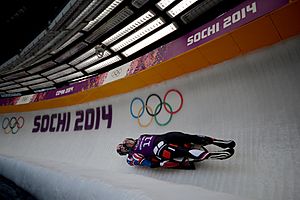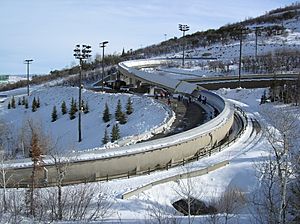Luge facts for kids
Luge is a thrilling Winter Olympics sport. It's a bit like bobsleigh, but it's known for being faster. It's a very exciting sport where athletes slide down an icy track on a small sled, feet first.
History of Luge
People have used sleds for a very long time, especially in snowy places. The first recorded sled races happened in Norway way back in the 1400s!
The sport of luge, along with skeleton and bobsleigh, started in the Swiss town of St. Moritz in the mid-to-late 1800s. A hotel owner named Caspar Badrutt helped make winter vacations popular there. His adventurous guests, many from England, started using sleds meant for deliveries as a fun activity. They would speed down the village lanes, which sometimes led to funny (and sometimes not so funny) bumps with people walking around!
The first organized luge event took place in Switzerland in 1883. Later, in 1913, the International Sled Sports Federation was created in Germany. This group managed the sport until 1935.
Luge was chosen to replace skeleton in the Olympic Games. The first World Championships for luge were held in 1955 in Norway. In 1957, the International Luge Federation (FIL) was founded. Luge became an official sport at the Olympic Winter Games in 1964.
Americans were a bit slower to get into luge. The first luge track in North America was built in Montana in 1965. Even though the United States competed in every Olympic luge event from 1964 to 1976, the United States Luge Association wasn't formed until 1979. The first special track for luge in America was finished that same year. It was used for the 1980 Winter Olympics in Lake Placid, New York.
Since then, the luge program in the United States has gotten much better. Another special track was built near Park City, Utah, for the 2002 Olympic Winter Games in Salt Lake City.
Artificial Tracks
Artificial luge tracks are specially built with high, banked curves and straight sections with walls. Most of these tracks are kept cold with artificial cooling, but some, like the one in St. Moritz, use natural ice. The tracks are usually very smooth.
Athletes lie flat on their sleds in an aerodynamic position, keeping their heads low. This helps them cut through the air and go faster. They steer the sled mainly with their calves: pressing their right calf turns the sled left, and their left calf turns it right. It's a careful mix of shifting their body weight, using their calves, and rolling their shoulders. There are also handles for small adjustments.
To be a successful luger, you need to stay totally focused and relaxed while going at very high speeds. Many lugers imagine the course in their minds before they slide. The fastest times happen when they follow the perfect "line" down the track. Even a tiny mistake, like touching the wall, can slow them down. The condition of the track also matters. Softer ice makes them go slower, while harder ice leads to faster times.
Lugers can reach average speeds of 120 to 145 kilometers per hour (75 to 90 miles per hour) around the high curves. They experience a force up to five times the force of gravity! In men's singles races, the start line is usually near where bobsled and skeleton athletes begin. For doubles and women's singles, the start line is a bit further down the track. Artificial track luge is the quickest and most agile sledding sport.
Natural Track Luge
Natural luge tracks are different. They are made from existing mountain roads and paths. They don't have artificially banked curves. The track surface is usually flat, and they are naturally iced by the weather. These tracks can get rough because of all the braking and steering.
Athletes on natural tracks use a special steering rope. They also drag their hands and use their legs to steer around the tight, flat corners. They often need to brake before curves, which they do by using spikes on the bottom of their shoes.
Most natural luge tracks are in Austria and Italy. You can also find them in other countries like Germany, Poland, and Canada. The Upper Peninsula Luge Club in Negaunee, Michigan, has one of only five lighted natural luge tracks in the world, and it's the only one in the United States. This track is over 800 meters (half a mile) long and has 29 curves. The club hosts international luge events and teaches people how to luge in the winter.
World championships for natural track luge have been held since 1979, and European championships since 1970.
Luge Events
There are four main types of luge events:
- Men's singles
- Doubles (where two people ride on one sled, open to both boys and girls)
- Women's singles
- Team relay (this became an Olympic event in 2014)
These events are also divided into different age groups. There are youth and junior classes for ages 7 to 20, and a general class for ages 21 and older. Older competitors can also enjoy the sport in masters (ages 30–50) and senior masters (ages 51+) classes.
In a team relay, one man, one woman, and a doubles pair form a team. When one competitor finishes their run, they touch a special pad at the bottom of the track. This signals the next teammate at the top to start their run.
Luge races have very specific rules:
- The starting order for the race is decided by a drawing. Athletes wear a number on a bib.
- In big national and international events, men's singles usually has four runs. Women's singles and doubles have two runs. The total time from all runs decides who wins. After the first run, the person who was slowest goes first in the next run, and the leader goes last.
- Officials check the sleds to make sure they meet size rules. They also check the temperature of the sled's steel blades, which can't be too warm.
- For artificial track races, athletes are weighed. This is to see if they can carry extra weight on their body to meet certain standards. This helps make the competition fair.
- Once an athlete is on their sled, they are told the track is clear. A sound then signals that they have thirty seconds to start their run.
- A run is official when the athlete and their sled, still in contact with each other, cross the finish line. If an athlete and sled are not touching when they cross the line, the athlete is disqualified. Athletes can also be disqualified for breaking other rules.
Images for kids
-
Georg Hackl from Germany is a very successful Olympic luger.
-
Armin Zöggeler from Italy is the first athlete to win a medal in six Olympic Games in a row.
-
German lugers Felix Loch (center) and David Möller (left) won first and second place in men's singles at the 2010 Winter Olympics.
See also
 In Spanish: Luge para niños
In Spanish: Luge para niños


